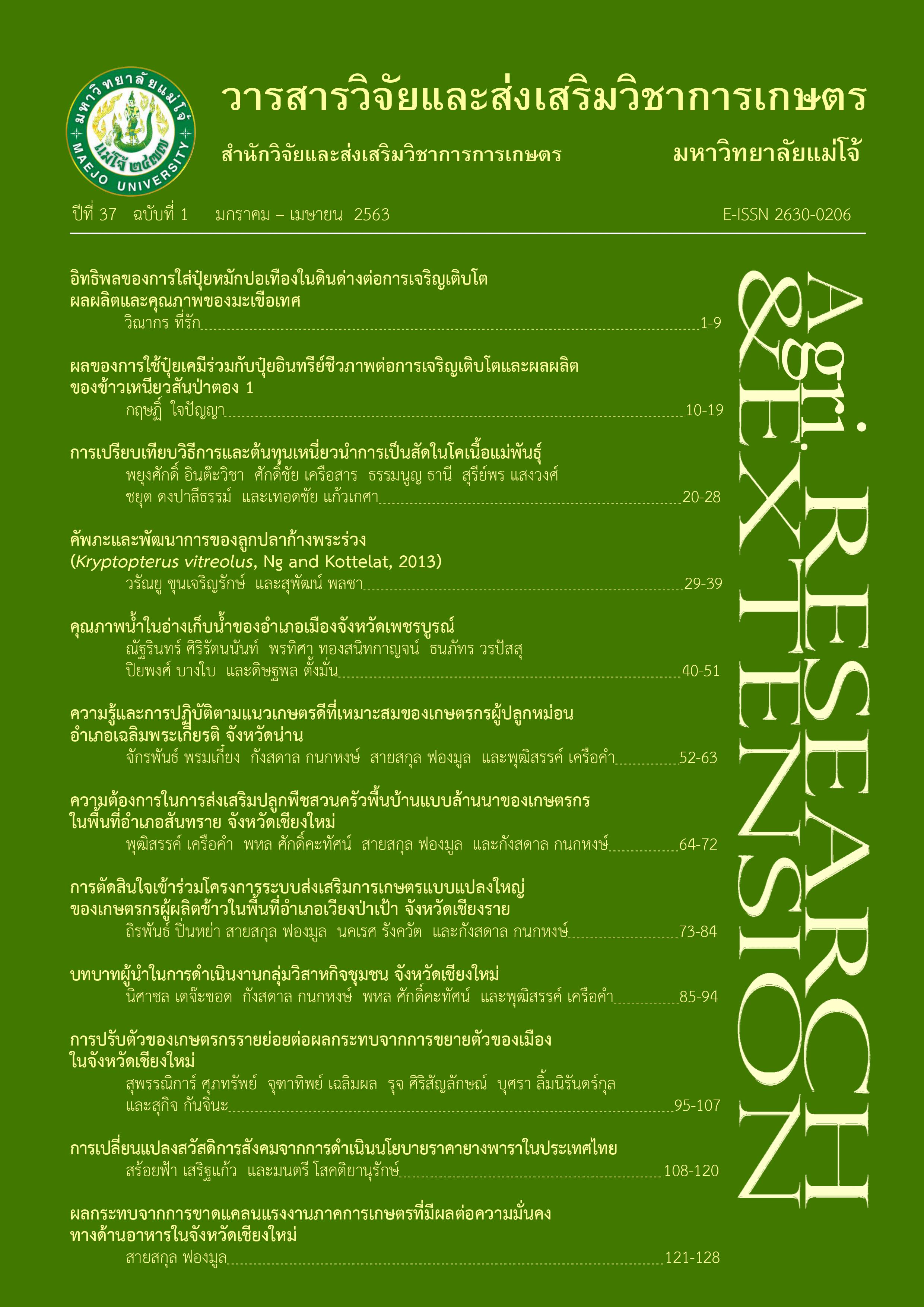การปรับตัวของเกษตรกรรายย่อยต่อผลกระทบจากการขยายตัวของเมืองในจังหวัดเชียงใหม่
คำสำคัญ:
การขยายตัวของเมือง, การปรับตัวของเกษตรกรบทคัดย่อ
การขยายตัวของเมืองเป็นผลลัพธ์จากการเติบโตของเศรษฐกิจกับการพัฒนาเมืองซึ่งมีตัวชี้วัดคือปริมาณประชากรและจำนวนสิ่งปลูกสร้างที่เพิ่มขึ้น เมื่อพื้นที่เมืองมีความแออัดมากขึ้นจึงเกิดการขยายตัวของเมืองเข้าสู่พื้นที่ข้างเคียงซึ่งแต่เดิมเป็นพื้นที่การเกษตรและชนบท ทำให้การใช้ประโยชน์ที่ดินในพื้นที่เปลี่ยนแปลงไป การศึกษานี้มีวัตถุประสงค์เพื่อศึกษาการปรับตัวของเกษตรกรรายย่อยและสภาพการเปลี่ยนแปลงด้านการผลิตทางการเกษตรในเขตพื้นที่ขยายตัวของเมือง จังหวัดเชียงใหม่ ได้แก่ อำเภอเมือง อำเภอแม่ริม และอำเภอหางดง จากการเก็บข้อมูลจากเจ้าหน้าที่รัฐที่เกี่ยวข้องและเกษตรกรรายย่อยในพื้นที่โดยการสนทนากลุ่มและการสัมภาษณ์ พบว่าการขยายตัวของเมืองส่งผลทั้งด้านบวกและลบต่อภาคการเกษตร ในด้านบวก ได้แก่การเข้าถึงตลาดมากขึ้นเนื่องจากความต้องการสินค้าเกษตรที่เพิ่มขึ้น และการเพิ่มขึ้นของจำนวนแรงงานทางการเกษตร ผลในด้านลบทำให้ราคาปัจจัยการผลิตก็เพิ่มสูงขึ้น ผลกระทบดังกล่าวทำให้เกษตรกรรายย่อยในพื้นที่เกิดการปรับตัว 3 ด้านคือ ด้านกายภาพ ด้านเศรษฐกิจ และด้านสังคม ซึ่งเห็นได้จากมีการปรับพื้นที่เพาะปลูกให้เป็นแหล่งท่องเที่ยวเชิงเกษตร รวมถึงการจัดตั้งกลุ่มเกษตรกรต่างๆ ขึ้นเพื่อส่งข่าวสารและแลกเปลี่ยนความรู้ด้านการผลิตทางการเกษตร
เอกสารอ้างอิง
Antrop, M. 2004. Landscape change and the urbanization process in Europe. Landscape and Urban Planning. 67: 9-26.
Bennett, W.J. 1969. The Northern Plainsmen: Adaptive Strategy and Agrarian Life. Chicago: Aldine. 352 p.
Chiang Mai Provincial Agricultural ExtensionOffice. 2018. Agricultural Information of Chiang Mai Production Year 2016/17. [Online]. Available: https://www.chiangmai.doae.go.th/reports/stat_plan/stat_plantproduction59-60.pdf (10 May 2019).
Deng, X., J. Huanga, S. Rozelleb, J. Zhang and Z.Li. 2015. Impact of urbanization on cultivated land changes in China. Land Use Policy 45: 1-7.
Elhadary, Y.A.E., N. Samat and F. Obeng-Odoom. 2013. Development at the Peri-urban area and its impact on agricultural activities: an example from the Seberang Perai region, Penang State, Malaysia. Agroecology and Sustainable Food Systems 37: 834-856.
Heimlich E.R. and H.C. Barnard. 1992. Agricultural adaptation to urbanization: farm types in northeast metropolitan areas. Journal of Agricultural and Resource Economics. 21(1): 50-60.
Hussain, Z. and M. Hanisch, 2014. Dynamics of Peri-urban agricultural development and farmers' adaptive behaviour in the emerging megacity of Hyderabad, India. Journal of Environmental Planning and Management 5(4): 495-515.
Inwood, M.S. and S.J. Sharp. 2012. Farm persistence and adaptation at the rural-urban interface: succession and farm adjustment. Journal of Rural Studies 28(1): 107-117.
Jiang, L., X. Deng and K.C. Seto. 2013. The impact of urban expansion on agricultural land use intensity in China. Land Use Policy 35: 33-39.
Jongkroy, P. and C. Thongbai. 2014. Patterns Of the Spatial Distribution of Urbanized Areas in Thailand. Kasetsart J. (Soc. Sci). 35, 30–44.
Kamal, N., M. Imran. and K.N.Tripati. 2016. Greening the Urban Environment Using Geospatial Techniques, A Case Study of Bangkok, Thailand. pp. 141-152. In International Conference - Green Urbanism, GU 2016 Italy: Elsevier.
Kazuaki T., Y. Harab. and D. Thaitakoo. 2015. Linking food and land systems for sustainable peri-urban agriculture in Bangkok metropolitan region. Landscape and Urban Planning 143: 192-204.
Kontothanasis G. 2017. Social practices of urban agriculture in the metropolitan region of Thessaloniki. Procedia Environmental Sciences 38: 666-673.
Larson, J. M., J.L. Findeis. and Smith, S. M. 2001. Agricultural adaptation to Urbanization in southeastern Pennsylvania. Agricultural and Resource Economics Review 30(1): 32-43.
Masters, W.A., A.A. Djurfeldt, C.D. Haan, P., Hazell, Jayne, T., Jirström, M. And Reardon, T. 2013. Urbanization and farm size in Asia and Africa: Implications for food security and agricultural research. Global Food Security, 2:156-165.
Naab, F.Z., R.D. Dinye. and R.K. Kasanga. 2013. Urbanization and its impact on agricultural lands in growing cities in developing countries: A case study of Tamale in Ghana. Modern Social Science Journal 2: 256-287.
National Statistic Office Thailand. 2017. Chiang Mai’s Provincial Statistic Report: Population and Housing Census. Chiang Mai: Chiang Mai Government Center. 255 p. [in Thai].
Olivier D.W. and L. Heinecken 2017. Beyond food security: women’s experiences of urban agriculture in Cape Town. Agriculture and Human Values. 34: 743-755.
Omondi, S.O., W.O. Kosura and M. Jirström 2017. The role of urban-based agriculture on food security: Kenyan case studies. Geographical Research. Institute of Australian Geographers 55(2): 231-241.
Oueslati, W., J. Salanié and J. Wu. 2014. Urbanization and agricultural structural adjustments: some lessons from European cities. 42 p. In Working paper. GATE Groupe: d’Analyse et de Théorie Économique Lyon-St Étienne.
Pham, V.C., T.-T.-H. Pham, T.H.A. Tong,T.T.H. Nguyen and N. H. Pham. 2014. The conversion of agricultural land in the peri-urban areas of Hanoi (Vietnam): patterns in space and time. Journal of Land Use Science, Taylor & Francis. 10(2): 224-242.
Redwood, M. 2009. Agriculture in Urban Planning: Generating Livelihoods and Food Security. London: International Development Research Centre. 248 p.
Siciliano, G. 2012. Urbanization strategies, rural development and land use changes in China: A multiple-level integrated assessment. Land Use Policy 29: 165-178.
Sioen, G.B., T. Terada, M. Sekiyama and M. Yokohari. 2018. Resilience with mixed agricultural and urban land uses in Tokyo, Japan. Sustainability 10(2): 1-27.
Suteethorn, K. 2012. The impacts of food miles on the pattern of footprint of Bangkok’s food supply. NAJUA: architecture, design and built environment. Journal of Faculty of Architecture 26: 71-94. [in Thai]
ดาวน์โหลด
เผยแพร่แล้ว
รูปแบบการอ้างอิง
ฉบับ
ประเภทบทความ
สัญญาอนุญาต
บทความนี้ได้รับการเผยแพร่ภายใต้สัญญาอนุญาต Creative Commons Attribution-NonCommercial-NoDerivatives 4.0 International (CC BY-NC-ND 4.0) ซึ่งอนุญาตให้ผู้อื่นสามารถแชร์บทความได้โดยให้เครดิตผู้เขียนและห้ามนำไปใช้เพื่อการค้าหรือดัดแปลง หากต้องการใช้งานซ้ำในลักษณะอื่น ๆ หรือการเผยแพร่ซ้ำ จำเป็นต้องได้รับอนุญาตจากวารสาร





